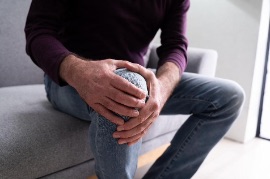Joint stiffness can be a major deterrent to staying active. Contrary to what you might think, however, stiff joints and muscles may become worse with rest and better with movement. Yes, exercise can actually help achy, arthritic joints feel better. Research shows that the cellular properties of muscles and joints respond well to simple stretching, strengthening, and coordination exercises to maintain and promote joint health.
 To better understand why exercise improves joint stiffness, let’s take a deeper look into the science of it. The state of balance in muscles and joints is determined by viscosity, or the internal friction, of the fluid within them. Think of it as the thickness or stickiness of a liquid. Thixotropy is the ability of a fluid to change its viscosity with movement.
To better understand why exercise improves joint stiffness, let’s take a deeper look into the science of it. The state of balance in muscles and joints is determined by viscosity, or the internal friction, of the fluid within them. Think of it as the thickness or stickiness of a liquid. Thixotropy is the ability of a fluid to change its viscosity with movement.
Clay, for instance, becomes thinner and more liquid-like when spun rapidly. Stop spinning it, and it thickens back up, often resulting in a beautiful vase. Muscles and joints possess the same property. When in motion, they loosen up. When sedentary, they become stiff. The longer they sit, the stiffer they become. The stiffer they become, the more uncomfortable you become.
A great way to start relieving joint stiffness is by stretching. You may think of relaxed muscles as limp, but they actually have some resistance to movement in order to protect the body from unexpected disturbances. This property is called muscle tone. Stretching helps reduce tone and stimulates synovial fluid moving through the joints, acting as oil would to lubricate an engine. Staying within a comfortable position and moving joints through their full range of motion allows for these processes to occur. Stretching also helps reduce muscle injury and improve joint mobility. Start with gentle dynamic (moving) stretches, and work into static (prolonged holding) stretches.
Strengthening muscles can also help prevent joint pain and stiffness. Muscles support joints and allow them to function properly. If the muscles surrounding a joint are weak, they will alter the movement of the joint, making it vulnerable to repeated inefficient loads, which may lead to injury or arthritis. Strong muscles promote healthy joint function, but you don’t have to reach for the barbell just yet. Simple weight bearing (standing) exercises with light dumbbells or resistance bands provide all you need for reducing joint stiffness.
Coordination exercises also reduce joint stiffness. They also improve balance and proprioception, the body’s awareness of its position in space. These movements should be small and done with lots of repetitions to reduce tissue viscosity around a joint; this will allow for easier movement. A great example of a simple coordination exercise is seated ankle circles, performed 20-30 times each on each foot. Try this and notice your ankle stiffness disappear!
Some of the newest science also points out that our perception of stiffness may have little to do with the actual stiffness of our joints. In a study by Stanton et al, 2017 they discovered that those who perceived (felt) back stiffness were more often in a cognitive state of protection and that feeling stiff did not correlate with objective measures of back stiffness. Movement can decrease the sensation of stiffness by all the reasons stated above, as well as by reducing fear of the joints and their ability to withstand force. All the more reason to keep moving!
Joint stiffness is a prevalent, nagging deterrent from getting active. But it shouldn’t stop you from keeping up with your exercise program. Remember that movement helps joint pain and stiffness. Ask your physical therapist about exercises you can do for your stiff joints today!
References
1. Lakie M, Campbell KS. Muscle thixotropy-where are we now?. J Appl Physiol (1985). 2019;126(6):1790-1799. doi:10.1152/japplphysiol.00788.2018.
2. Kubo K, Ikebukuro T. Changes in joint, muscle, and tendon stiffness following repeated hopping exercise. Physiol Rep. 2019;7(19):e14237. doi:10.14814/phy2.14237.
3. Behm DG, Blazevich AJ, Kay AD, McHugh M. Acute effects of muscle stretching on physical performance, range of motion, and injury incidence in healthy active individuals: a systematic review. Appl Physiol Nutr Metab. 2016;41(1):1-11. doi:10.1139/apnm-2015-0235.
4. Owens C, Conaghan PG. Improving joint pain and function in osteoarthritis. Practitioner. 2016 Dec;260(1799):17-20. PMID: 29020716.
5. Tasha R. Stanton, G. Lorimer Moseley, Arnold Y. L. Wong & Gregory N. Kawchuk Feeling stiffness in the back: a protective perceptual inference in chronic back pain www.Nature.com SCIENTIFIC Reports| 7: 9681 | DOI:10.1038/s41598-017-09429-1




